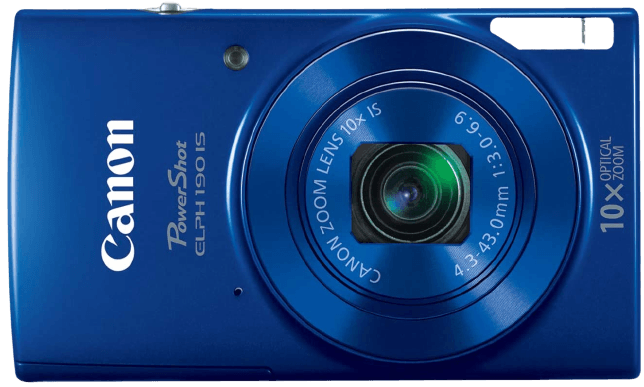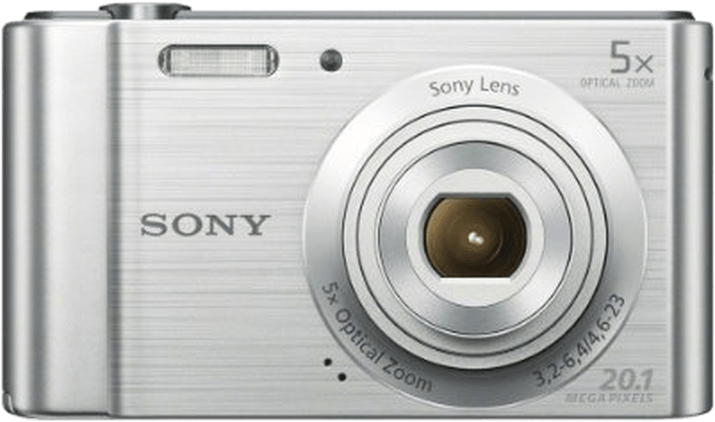Canon PowerShot ELPH 190 IS vs Sony Cyber-shot DSC-W800/B Comparison
Canon PowerShot ELPH 190 IS

Sony Cyber-shot DSC-W800/B

The Sony Cyber-shot DSC-W800/B is the winner in this comparison with a score of 53/100, while the Canon PowerShot ELPH 190 IS scores 44/100. Both cameras are compact, released in 2014 and 2016 respectively, and have similar camera sizes and weights. However, the Canon PowerShot ELPH 190 IS is slightly larger and heavier than the Sony Cyber-shot DSC-W800/B.
The Sony Cyber-shot DSC-W800/B has a significant advantage in terms of price, as it was launched at $80, while the Canon PowerShot ELPH 190 IS had a launch price of $160. This makes the Sony camera more affordable and budget-friendly.
On the other hand, the Canon PowerShot ELPH 190 IS has a slightly more recent release date, which could indicate more advanced features or technology. However, this does not seem to have a significant impact on the overall scores of the cameras.
In conclusion, the Sony Cyber-shot DSC-W800/B is the better option due to its higher score, more affordable price, and lighter weight. The Canon PowerShot ELPH 190 IS may have a more recent release date, but it does not offer enough advantages to outweigh its higher price and lower score.
Canon PowerShot ELPH 190 IS vs Sony Cyber-shot DSC-W800/B Overview and Optics
The Sony Cyber-shot DSC-W800/B takes the lead in optics with a score of 60/100, outperforming the Canon PowerShot ELPH 190 IS, which scored 53/100. Both cameras share common specifications, such as 20-megapixel sensors, a 1/2.3″ sensor size, CCD sensor type, fixed lens mounts, and image stabilization.
The Sony Cyber-shot DSC-W800/B’s superiority lies in its shooting speed and sensor performance. With a shooting speed of 1 frame per second, it surpasses the Canon PowerShot ELPH 190 IS’s 0.8 frames per second. Additionally, the Sony camera’s DXOMARK score for the sensor is 91, significantly higher than the Canon’s 66. This indicates that the Sony Cyber-shot DSC-W800/B captures images with better quality and detail.
Conversely, the Canon PowerShot ELPH 190 IS does not surpass the Sony Cyber-shot DSC-W800/B in any specific area. However, it is important to note that the Canon camera uses a Digic 4+ processor, while the Sony camera utilizes a Bionz processor. Although this does not translate into a direct advantage, it may influence the overall performance and user experience of each camera.
Taking all factors into consideration, the Sony Cyber-shot DSC-W800/B emerges as the better option in terms of optics. Its faster shooting speed and higher sensor score contribute to its superior image quality. On the other hand, the Canon PowerShot ELPH 190 IS falls short in these areas but may still provide satisfactory results for casual photographers.
Canon PowerShot ELPH 190 IS vs Sony Cyber-shot DSC-W800/B Video Performance
The Canon PowerShot ELPH 190 IS and the Sony Cyber-shot DSC-W800/B have identical video scores of 34/100. Both cameras share common video specifications, such as maximum video resolution of Standard HD, maximum video dimensions of 1280 x 720, maximum video frame rate of 30fps, and neither camera has built-in time-lapse functionality.
In terms of video capabilities, neither camera stands out as superior to the other. Both cameras provide the same level of video quality and performance, making them equally suitable for users interested in basic video recording. As both cameras have the same video score and specifications, it is not possible to determine a clear winner in this category.
However, there may be other factors beyond video capabilities that could influence a user’s choice between these two cameras. These factors may include differences in design, size, weight, and additional features not related to video recording. It is essential to consider these factors when deciding which camera to purchase.
In comparing the Canon PowerShot ELPH 190 IS and the Sony Cyber-shot DSC-W800/B, it is evident that their video capabilities are evenly matched. Both cameras offer the same level of video quality and performance, making them suitable for users who require basic video recording functionality. Additional factors not related to video capabilities should be considered when choosing between these two cameras.
Canon PowerShot ELPH 190 IS vs Sony Cyber-shot DSC-W800/B Features and Benefits
The Sony Cyber-shot DSC-W800/B comes out as the winner in terms of features, with a score of 47/100, while the Canon PowerShot ELPH 190 IS scores 34/100. Both cameras share some similarities in their specifications, such as having a 2.7-inch screen size and a screen resolution of 230,000 dots. Neither camera has a touchscreen or GPS, but both offer WIFI connectivity.
The Sony Cyber-shot DSC-W800/B stands out as the better camera in terms of features, primarily due to its flip screen and bluetooth capabilities. The flip screen provides more flexibility when composing shots, especially in challenging angles or when capturing self-portraits. Additionally, the bluetooth feature allows for seamless connectivity with other devices, making it easier to transfer and share images.
The Canon PowerShot ELPH 190 IS, despite having a lower feature score, does not have any distinct advantages over the Sony Cyber-shot DSC-W800/B in this comparison. Both cameras have the same screen size, resolution, and lack of touchscreen. However, the Canon camera does not have a flip screen or bluetooth, which puts it at a disadvantage compared to the Sony model.
Considering the features of both cameras, the Sony Cyber-shot DSC-W800/B is the superior choice due to its flip screen and bluetooth connectivity. These additional features provide more versatility and convenience for users, making it a better option compared to the Canon PowerShot ELPH 190 IS.
Canon PowerShot ELPH 190 IS vs Sony Cyber-shot DSC-W800/B Storage and Battery
The Sony Cyber-shot DSC-W800/B wins the storage and battery comparison with a score of 13/100, while the Canon PowerShot ELPH 190 IS scores 11/100. Both cameras have a single memory card slot and accept SD, SDHC, and SDXC cards.
The Sony Cyber-shot DSC-W800/B has a longer battery life of 200 shots, compared to the Canon PowerShot ELPH 190 IS’s 190 shots. Additionally, the Sony camera supports Memory Stick Pro Duo and Pro-HG Duo cards, giving it an edge in storage versatility.
The Canon PowerShot ELPH 190 IS, however, has no significant advantages in storage and battery over the Sony Cyber-shot DSC-W800/B.
This comparison reveals that the Sony Cyber-shot DSC-W800/B is the better choice for storage and battery performance, with a longer battery life and greater memory card compatibility.
Canon PowerShot ELPH 190 IS vs Sony Cyber-shot DSC-W800/B – Our Verdict
Are you still undecided about which camera is right for you? Have a look at these popular comparisons that feature the Canon PowerShot ELPH 190 IS or the Sony Cyber-shot DSC-W800/B:
